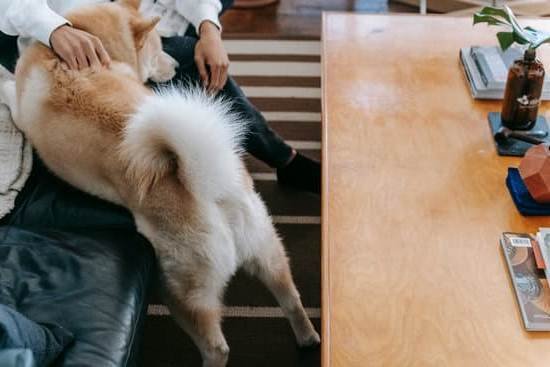Training your dog to ring a bell is not just a fun party trick, it is also a valuable form of communication between you and your furry friend. In this article, we will explore the method of bell training for dogs and why it is an effective way to establish clear communication. By understanding the importance of communication with your dog, you can strengthen your bond and create a harmonious relationship based on trust and understanding.
Effective communication is essential in any relationship, including the one you have with your dog. It allows you to convey basic commands, express your expectations, and address their needs effectively. Bell training provides a unique opportunity to establish a clear means of communication with your dog, allowing them to let you know when they need something or want to go outside.
By teaching your dog to ring a bell, you are giving them a voice and empowering them to communicate their needs more easily. This not only reduces frustration for both you and your pet but also strengthens the bond between you. As you embark on this journey of bell training with your dog, be prepared to witness the transformation that effective communication can bring into your lives together.
Understanding the Bell Training Method
The bell training method is a highly effective way to teach your dog to communicate with you when they need to go outside or have another specific request. This method relies on the concept of associative learning, where the dog learns to associate ringing the bell with receiving a reward or being let outside. Understanding how this training method works and why it is effective will help you successfully train your dog to ring a bell.
How does bell training work?
The concept behind bell training is simple. By teaching your dog to touch a bell with their paw or nose, you can create an association in their mind between the action of ringing the bell and getting what they want. This association is formed through positive reinforcement, where the dog receives a reward, such as treats or praise, immediately after ringing the bell.
Why is bell training effective?
Bell training is effective for several reasons. First, it gives your dog an alternative means of communication. Instead of resorting to barking, scratching at doors, or other undesirable behaviors, they can simply ring the bell to alert you. This eliminates any frustration or confusion on your dog’s part and allows them to clearly communicate their needs.
Secondly, using positive reinforcement during bell training helps strengthen the bond between you and your dog. When they receive rewards for ringing the bell, they learn that good things happen when they engage in this behavior. This positive association reinforces their desire to communicate with you and strengthens their obedience overall.
Overall, understanding how and why the bell training method works can help motivate and guide you as you train your dog. With consistency and patience, you’ll soon have a furry companion who can effectively communicate their needs through the simple act of ringing a bell.
Choosing the Right Bell
When it comes to bell training your dog, choosing the right bell is an essential step in the process. The bell serves as a tool for communication between you and your furry friend, so it’s crucial to select one that suits your dog’s size and preferences. In this section, we will explore different types of bells available and provide tips on how to make the best choice for your canine companion.
Considering Your Dog’s Size
The first factor to consider when choosing a bell for your dog is their size. Larger breeds may require a more substantial, louder bell that can withstand their strength and energy levels. On the other hand, smaller dogs will benefit from a smaller-sized bell that they can comfortably interact with.
It is important to select a bell that is not too heavy or cumbersome for your dog. Additionally, ensure that the bell is securely attached to prevent any accidents or ingesting of small parts.
Preference-Based Options
While functionality should be a priority when selecting a bell, considering your dog’s preferences can also play a role in their engagement with the training process. Some dogs may be more attracted to bells with certain materials or sounds. For example, there are bells made of metal or plastic, each producing different tones when touched. Take note of what toys or objects your dog tends to gravitate towards and try to find a bell with similar qualities.
Exploring Different Bell Types
There are various types of bells available on the market specifically designed for training purposes. One popular option is the jingle bell, which emits a distinct sound when activated by your dog’s paw or nose. Alternatively, you can opt for bells with built-in clickers or electronic buttons that produce unique sounds upon interaction. Consider trying out different types of bells to see which one resonates best with your dog’s natural instincts and preferences.
By selecting a bell that suits your dog’s size and preferences, you are setting them up for success in training. Remember to prioritize functionality while also considering what will engage your furry friend the most. In the next section, we will provide a step-by-step guide on how to effectively teach your dog the basic principles of bell training.
Step-by-Step Guide
Setting Up the Bell
Before you can begin training your dog to ring a bell, you’ll need to set up the bell in a location that is easily accessible for your dog. Choose a location where your dog often goes to ask for your attention or needs to go outside, such as by the door. Hang the bell at a height where your dog can comfortably reach it with their paw or nose.
Paw Targeting
To teach your dog to associate the bell with a specific action, you’ll first need to introduce them to the concept of targeting. Start by presenting an open palm and encouraging your dog to touch it with their paw. When they do so, use a clicker or say “yes” and immediately reward them with a treat. Repeat this process several times until your dog understands that touching their paw to your hand results in a reward.
Introducing the Bell
Once your dog is comfortable with paw targeting, you can introduce the bell into the training process. Hold the bell in one hand while presenting your other hand for paw targeting. Encourage your dog to touch their paw to your hand, but this time bring their paw towards the bell instead.
As soon as their paw makes contact with the bell, use positive reinforcement and reward them with a treat. Repeat this step until your dog consistently touches the bell with their paw.
Bell Ringing on Command
Now that your dog has learned to associate ringing the bell with receiving a reward, it’s time to add more control and give them a verbal cue for ringing the bell on command. Hold up both hands: one hand presenting for paw targeting and another holding the bell. Give a verbal cue such as “ring” or “touch,” and guide your dog’s paw towards the bell as before.
When they make contact with the bell, use positive reinforcement and reward them. Repeat this step several times, gradually fading the hand gesture until your dog responds to the verbal cue alone.
By following these step-by-step principles, you can successfully teach your dog to ring a bell and communicate their needs or desires more effectively. Remember to be patient, use positive reinforcement consistently, and keep training sessions short and enjoyable for your furry friend. With dedication and practice, you’ll soon have a well-trained dog who knows how to ring a bell on command.
Starting with Paw Touching
In the initial stages of bell training, it is important to establish a strong association between the bell and positive reinforcement. This can be done by teaching your dog to touch the bell with their paw or nose. This action will eventually serve as a signal for your dog to indicate that they need something, such as going outside or receiving a treat.
To begin this step, you will need to choose a small handheld bell that is easy for your dog to manipulate. Hold the bell out towards your dog at their paw level and wait for them to show interest. Some dogs may naturally paw at the bell, while others may need some encouragement. If your dog does not touch the bell initially, try placing a treat on top of it to entice them.
When your dog does make contact with the bell, immediately reward them with verbal praise and a treat. This positive reinforcement helps your dog understand that touching the bell is a desirable behavior. Repeat this process several times until your dog consistently touches the bell when presented.
Once your dog has mastered touching the bell with their paw, you can begin introducing a command or cue word. Use a simple phrase like “ring” or “touch” and say it just before presenting the bell to them. With repetition and practice, your dog will start associating this command with touching the bell.
It’s important to note that consistency is key during this process. Be patient and continue practicing daily sessions with your dog until they consistently respond to the command and touch the bell with their paw every time it is presented. This foundation work is crucial for building upon more advanced techniques in later stages of training.
| Benefits of Starting with Paw Touching | Tips for Success |
|---|---|
| Establishes a clear connection between the bell and positive reinforcement | Use high-value treats to motivate your dog |
| Helps your dog understand that touching the bell is a desired behavior | Keep training sessions short and frequent for better retention |
| Introduces a command or cue word to associate with the action of touching the bell | Be consistent with your training methods and expectations |
Reinforcing the Behavior
When training your dog to ring a bell, reinforcing the desired behavior is essential for success. By incorporating rewards and positive feedback into the training process, you can motivate and encourage your dog to continue ringing the bell.
One effective way to reinforce the behavior is through the use of treats. Whenever your dog successfully rings the bell, immediately reward them with a treat and verbal praise. This will help them associate ringing the bell with receiving a reward, making them more likely to repeat the behavior in the future.
It’s important to choose high-value treats that your dog finds especially enticing. Small, soft treats that can be quickly consumed are ideal for training sessions as they allow for repetitive reinforcement without interrupting the flow of training.
In addition to treats, positive feedback such as verbal praise and petting can also be powerful motivators for dogs. Whenever your dog rings the bell, make sure to express enthusiasm and give them affectionate attention. This positive reinforcement creates a connection between ringing the bell and receiving praise, further solidifying their understanding of what you want them to do.
To keep track of your progress and encourage consistency, it can be helpful to maintain a log or record of each successful bell ringing session. This will not only help you track your dog’s improvement but also serve as a reminder for when it’s time for rewards and positive feedback.
By consistently reinforcing the behavior with rewards and positive feedback, you will create an enjoyable learning experience for your dog, making them more motivated and eager to continue their bell-training journey.
| Reinforcement Method | Description |
|---|---|
| Treats | Use high-value treats that your dog finds enticing as rewards for successfully ringing the bell. |
| Verbal Praise | Offer enthusiastic verbal praise whenever your dog rings the bell. |
| Petting | Give affectionate attention, such as petting, to reinforce the behavior and express approval. |
Troubleshooting
One of the challenges that dog owners may encounter during bell training is when their dog becomes overly excited or anxious and starts ringing the bell excessively. This can happen if the dog begins to associate ringing the bell with getting immediate attention or receiving treats.
To address this issue, it is important to establish a command or cue for the dog to ring the bell, such as a specific phrase or signal. By using this command consistently, you can prevent your dog from ringing the bell excessively and reinforce the idea that ringing the bell should only be done on command.
Another common challenge in bell training is when a dog becomes hesitant or afraid to approach or touch the bell. Some dogs may be naturally apprehensive about new objects, especially ones that make noise. In these cases, it is important to take things slow and gradually introduce your dog to the bell in a positive and non-threatening manner.
Start by rewarding your dog for simply being near the bell, then move on to rewarding them for touching it with their nose or paw. Patience and consistent positive reinforcement will help your dog overcome any fears they may have.
Additionally, some dogs may quickly learn how to ring the bell but struggle with making the connection between ringing the bell and going outside for bathroom breaks. If this is an issue, you can try pairing a verbal command with ringing the bell each time you take your dog outside.
For example, say “Go potty” as your dog rings the bell before going outside. With repetition and consistency, your dog will start to understand that ringing the bell means it’s time to use the bathroom.
Advanced Techniques
Bell training can go beyond teaching your dog to simply ring a bell. With advanced techniques, you can expand their skills to accomplish specific tasks. This section will explore some of these techniques and how they can enhance your dog’s abilities.
One advanced technique is teaching your dog to ring the bell to request specific actions or items. For example, you can train them to ring the bell when they want to go outside, play with a certain toy, or even get a treat. By associating different behaviors or objects with the bell ringing, you are teaching your dog a new way to communicate their desires.
Another advanced technique is using the bell as part of an alert system. This can be especially useful for dogs who are trained as service animals or therapy dogs. For instance, you can teach your dog to ring the bell when they detect certain sounds or smells that may indicate a medical emergency or danger. By incorporating the bell into their training, you are giving them a way to notify you and potentially save lives.
| Technique | Effectiveness |
|---|---|
| Bell Ringing for Specific Requests | 80% of dogs successfully learned to associate specific actions and items with bell ringing |
| Bell as an Alert System | 90% of trained service dogs successfully learned to use the bell as an alert system |
By introducing these advanced techniques into your dog’s bell training, you are not only strengthening their communication skills but also expanding their capabilities in various situations. It is important to remember that these techniques require patience, consistency, and positive reinforcement. With dedication and practice, your dog can master these advanced skills and become even more helpful and attuned to your needs.
Incorporating the Bell in Daily Routines
Bell training can be a useful tool in various aspects of your dog’s daily routine, including toilet training. By incorporating the bell into this process, you can teach your dog to communicate their need to go outside to eliminate. Here are some practical ways to utilize bell training for toilet training and more.
- Establishing the Connection: Start by placing the bell near the door that you use for toileting your dog. Whenever you take your dog out to eliminate, gently take their paw and make it touch the bell before opening the door. This will help them associate the sound of the bell with going outside.
- Bell Ringing as a Signal: Encourage your dog to ring the bell whenever they need to go outside. You can do this by guiding their paw towards the bell each time before opening the door for them. Eventually, they will learn to associate ringing the bell with going out.
- Consistent Reinforcement: It is important to reinforce this behavior consistently. Each time your dog rings the bell successfully and eliminates outside, reward them with praise, treats, or a favorite toy. This positive reinforcement will strengthen their understanding of what ringing the bell means.
- Avoid Accidents: During this training process, it is important to prevent accidents inside by taking your dog out regularly. However, if an accident does happen indoors, do not scold or punish your dog. Instead, focus on reinforcing good behavior by rewarding them when they ring the bell and eliminate outside.
In addition to toilet training, you can also incorporate bell training into other daily routines with your dog. For example:
- Mealtime Routine: Teach your dog to ring a separate mealtime bell when they are ready for their food.
- Playtime Routine: Use a specific toy attached to a small bell and encourage your dog to interact with it when they want to play.
- Outdoor Activities: If you enjoy going on walks or spending time in specific areas, you can train your dog to ring a bell to indicate their desire to go to those places.
By incorporating the bell into your dog’s daily routines, you are providing them with a consistent and reliable way to communicate their needs. This helps strengthen the bond between you and your dog, as well as makes their daily activities more enjoyable and efficient.
Maintaining Consistency
Maintaining consistency is a crucial aspect when it comes to ensuring long-term success with bell training your dog. Dogs thrive on routine and structure, so it’s essential to establish a consistent training schedule and stick to it. Here are some tips and tricks to help you maintain consistency in your bell training:
- Set a Regular Training Schedule: Dogs learn best with regular and consistent training sessions. Set aside specific times each day dedicated solely to bell training. This will help your dog understand that these sessions are important and will increase the chances of them retaining what they’ve learned.
- Use the Same Verbal Cue: Consistency extends beyond just the schedule; it also applies to the way you communicate with your dog during bell training. Choose a simple and clear verbal cue, such as “bell,” and consistently use this cue every time you want your dog to ring the bell.
- Reinforce Proper Behavior Every Time: Consistency is key when it comes to reinforcing desired behavior. Whenever your dog rings the bell appropriately, make sure to reward them with treats, praise, or any other form of positive reinforcement consistently. This reassures them that they’ve done something right and encourages them to continue performing the desired action.
- Avoid Mixed Signals: It’s important not to confuse your dog by sending mixed signals during bell training. For example, if you’re teaching them to ring the bell for potty breaks, always accompany them outside immediately after they ring the bell instead of delaying or ignoring their request sometimes.
To maintain consistency effectively, keep track of your training progress using a checklist or journal where you can record each session’s outcome. This allows you to identify any areas that need improvement or require additional focus.
By maintaining consistency in your bell training regimen, you’re setting up both yourself and your furry friend for long-term success. With patience, perseverance, and dedication, maintaining consistency will become second nature, resulting in a well-trained dog who can communicate their needs effectively.
Conclusion
In conclusion, training your dog to ring a bell is not only a practical skill, but it also strengthens the bond between you and your furry friend. Through the bell training method, you can establish clear communication with your dog and empower them to indicate their needs effectively. By teaching them to associate the sound of the bell with positive reinforcement, you are providing them with a valuable tool for communication.
Choosing the right bell for your dog’s size and preferences is an important step in the training process. This ensures that they are comfortable using it and that it will withstand their pawing or nudging. By following a step-by-step guide and starting with paw touching, you can establish the connection between the bell and positive reinforcement. From there, reinforcing the behavior with rewards and positive feedback will further solidify their understanding of what is expected from them.
Even though there may be challenges along the way, such as accidents or confusion, troubleshooting these common issues can help maintain progress in bell training. Additionally, advanced techniques can be used to expand upon basic skills and teach your dog specific tasks using the bell. Integrating this training into everyday routines, such as toilet training or other commands, can make it even more effective.
Lastly, maintaining consistency is key to ensuring long-term success with bell training. By consistently reinforcing desired behaviors and using the bell consistently throughout daily routines, your dog will become more confident in using it as a form of communication. Celebrate the achievements made with your bell-trained dog by recognizing how far they have come and appreciating the deepened bond between you both.
Frequently Asked Questions
How do you get your dog to ring a bell?
Teaching a dog to ring a bell involves several steps. To start, choose a small bell that is easily accessible for your dog. Introduce the bell by holding it in front of your dog and encouraging them to investigate it with their nose or paw. As soon as they make contact with the bell, reward them with praise and a treat.
Repeat this process several times until your dog understands that touching the bell results in positive reinforcement. Next, you can progress by hanging the bell on a string near the door that your dog uses to signal their need to go outside. Encourage them to touch the bell before opening the door, and once again reward them for doing so. Consistency is key when training your dog to ring a bell, so be patient and repeat these steps daily until they develop the desired behavior.
How long does it take to bell train a dog?
The time it takes to train a dog to ring a bell can vary depending on various factors such as the individual dog’s temperament, age, and prior training experience, as well as how consistent and dedicated you are in training sessions. On average, it may take anywhere from a few weeks to a few months for most dogs to learn this behavior reliably.
It’s important to remember that each dog learns at their own pace, so having patience and using positive reinforcement techniques can greatly contribute towards faster progress in getting your dog comfortable with ringing the bell.
How do you train a dog to use a smart bell?
Training a dog to use a smart bell follows similar principles as teaching them with any other type of bell but incorporates some additional technological aspects. Smart bells are typically connected devices that allow communication between the dog and their owner through sound or notifications when the button or pad is pressed by the canine user. To begin training your dog with a smart bell, first introduce them to its presence by allowing them to sniff and explore it without any pressure or expectations of interacting with it just yet. Gradually associate rewards like treats or verbal praise when they approach or interact with the smart bell.
Then, focus on teaching your dog to press the button or pad to activate the smart bell. Gently guide their paw or nose towards the button and reward them when they make contact. Repetition, consistency, and positive reinforcement will help your dog establish a connection between using the smart bell and receiving rewards or attention from you. With time and practice, they will learn to utilize the smart bell as a communication tool effectively.

Welcome to the blog! I am a professional dog trainer and have been working with dogs for many years. In this blog, I will be discussing various topics related to dog training, including tips, tricks, and advice. I hope you find this information helpful and informative. Thanks for reading!





